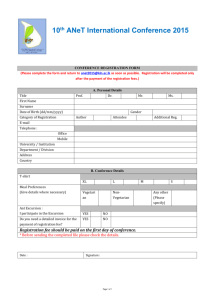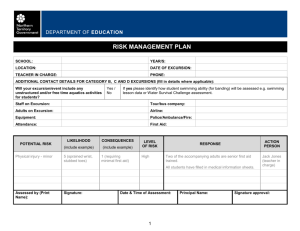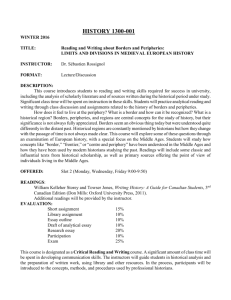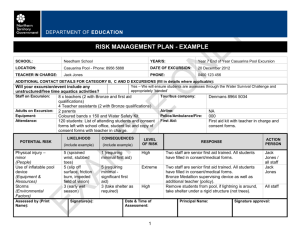What is Peripherisation and what makes Peripheries - UEF-Wiki
advertisement
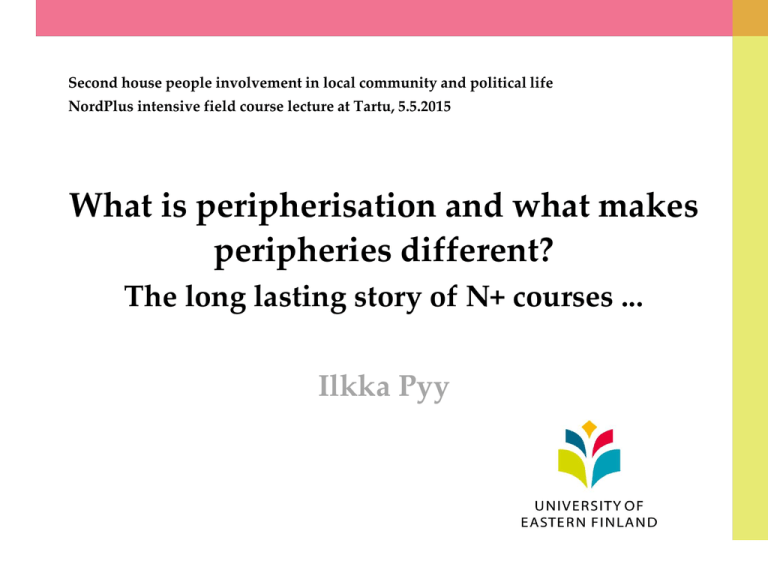
Second house people involvement in local community and political life NordPlus intensive field course lecture at Tartu, 5.5.2015 What is peripherisation and what makes peripheries different? The long lasting story of N+ courses ... Ilkka Pyy Peripheries, second-homes – everyday and academic perspectives • Periphery and boundary both are products of nation state building – in many respects e.g. Joensuu is much more peripheral in national than in global context • Why to bother to study peripheries? – Problem sites, which preserve conservative values but ruin the nature, do not offer decent income but imitate the ways of life from the centers – Idyll sites, where small is beautiful and where the assessment of societal change and development can be done from the distance and deeply • “It is clear that peripherality is, or should be, a contextual category rather than a mere technical instrument to be employed in the classification of social – mainly economic – space. … peripherality should be a contextual but is also a relativistic category; there are no ‘absolute’ peripheries.” (Paasi 1995, 253-4) • ”However, there still seems to be some agreement that the role of second-home phenomena for regional development is not fully understood. Thus, Second Homes: Curse or Blessing? [1977] remains a powerful reminder that scientific problems are not solved easily, particularly since they are objects of continuous change and diversification.” (Müller & Hoogendoorn 2013, 366) Esityksen nimi / Tekijä 5.5..2015 2 What is Peripherisation and what makes peripheries different? Table of contents •(Extensive) perspectives to peripheries •Investigating and studying peripheries – N+ field course story •Peripherisation and regionalisation – From dualisms . . . – . . . to three-fold analyses of differentiated peripheries . . . – . . . and towards intensive development & training strategies Ilkka Pyy 5.5..2015 3 Extensive perspectives to peripheries The dimensions of (the Northern) peripheries Regional differentiation can be divided into core areas and peripheral areas. We can see this division on different regional scales from global to local. The cores are typically diverse centres of economic growth, political power, culture life etc. Main characteristics of peripheral regions: “Peripheral in both a spatial and a social sense means being out of the centre of resources, such as wealth, power, or connection” (Oksa 1995,183). • geographically remote (distance to/from centers), territorially remote (border areas) • dependent up on external political and industrial decision-making • resource-based economy (agriculture, forestry, mining, fishing) • strong dependence on the state as provider of employment, services, subsidies etc. • relatively low levels of income, education, health, housing etc. • culturally traditional • decline of population, employment, services • out-migration of young people, aging of the population • unfavourable climate and geological conditions (archipelago, mountainous etc.) Peripherality as an expenditure factor: some Nordic features LOW POPULATION DENSITY AND LONG DISTANCES A The share of people living outside population centres (the share of people in sparsely populated areas) B The density of the people living in sparsely populated areas - conventional density: average number of inhabitants/km2 - grid square model of density: average number of inhabitants/populated km2-grids C Wideness - the size of the area - the length of general roads - the average distance of farms from the population centre REMOTE LOCATION D The distance from the population as a demand potential - the lack of collaboration possibilities - the lack of purchasing power - the lack of political power E The distance to the town centres F The site of location on the border OTHER FACTORS OF UNFAVOURABILITY (RELATED TO REMOTENESS) - bilingualism - special support for salaries in remote municipalities Esityksen nimi / Tekijä 5.5..2015 6 Two population densities (Rusanen et al. 1993) Population in municipality / areal size of municipality (km²) Population in inhabited grids (1 km²) according to municipal division Remoteness index according to crow fly Remoteness index (Pyy 1996) Remoteness index according to road distance Source: Simo Rautianen 2015 5.5..2015 8 Remoteness index according to road distance The impact of water bodies by increasing remoteness Index category Remoteness Population / 2 km² grid remoteness index rate Population in index grids 2013 Hirvensalmi Mikkeli Savonlinna Enonkoski Puumala Sulkava Category change Archipelago 0,00 - 0,99 1,00 - 1,49 1 2 094 53 458 33 375 332 0 309 1,5 161 1 029 1 360 1 102 195 1 996 1,50 - 2,00 fixed charge 3 207,12 €/resident 83 148 1 521 88 2 124 489 lump sum charge 368,87 €/resident Specified revenue Present revenue Total Specified revenue (€) (€) population (€) 422 208 0 2 338 862 418 1 258 931 0 54 635 20 153 212 4 557 633 755 315 36 256 13 373 751 557 734 35 806 1 522 561 420 2 327 532 369 487 2 319 855 410 1 265 409 230 928 2 794 1 030 623 Source: Simo Rautianen 2015 5.5..2015 9 Investigating and studying peripheries Nordplus research areas in 1999-2015 Source of the map: Spiekermann, K. & Aalbu, H., Nordic Peripherality in Europe. Nordregio Working Paper 2004:2 NordPlus –course themes 1999-2015 (2016?) • 27.9. – 8.10. 1999 in Saltdal, Rognan (140 km south-east of Bodø) with a 3-days excursion to Rana, Lurøy and Træna: LOCAL RESTRUCTURING OF THE NORDIC WELFARE SOCIETY • 3.-14.11.2008 in Pärnu with a 3-days excursion to Southern Estonia: RESILIENT REGIONS AND PEOPLE: TRANSFORMATION AND ADAPTATION OF LOCAL ECONOMIES • 2. – 13.10. 2000 in Saltstraumen (30 km east of Bodø) with a 3-days excursion to the Lofoten Islands: INNOVATIONS, ENTREPRENEURSHIP AND REGIONAL DEVELOPMENT IN THE NORDIC CONTEXT • 5.-16.10.2009 in Valga-Valka with excursions along Via Hansaetica between Tartu and Riga: NEW FORMS OF POSTPRODUCTIVISM, RURAL-URBAN INTERACTION AND REGIONALISM IN BALTIC BORDERLANDS • 30.9. – 11.10. 2002 in Røkland (100 km south-east of Bodø) with a 3-days excursion to the Lofoten Islands: SOCIAL CAPITAL, LOCAL MOBILIZATION AND REGIONAL DEVELOPMENT IN THE NORDIC CONTEXT • 19. – 31.10. 2003 in Tornio/Haparanda with a 3-days excursion to Luleå, Piteå, Pajala, Pello, Rovaniemi and Kemi: LEARNING REGIONS AND CROSS-BORDER COOPERATION IN THE NORDIC PERIPHERY • 4. – 15.10. 2004 in Ylitornio with a 4-days excursion to Kolari, Enontekiö, Kautokeino, Karasjokk, Utsjoki, Inari and Rovaniemi: NEW DYNAMICS OF ETHNIC AND REGIONAL POLITICS IN THE NORDIC PERIPHERY • 2. – 13.10. 2006 in Ylitornio with a 3-days excursion to Pajala, Kiruna, Gällivare, Jokkmokk, Boden and Luleå: MOBILITY IN A BRIDGING AND BONDING CAPACITY IN THE NORDIC PERIPHERY • 1.-12.10.2007 in Kuusamo with a 4-days excursion to Eastern Lapland and Rovaniemi: MAPPING TACIT KNOWLEDGES. UNDERSTANDING THE TRANSFORMATIONS OF RURAL ECONOMIES • 11.-22.10.2010 in Riga with a 3-days excursion to Eastern Latvia (Latgale): DUALISMS AND DIALOGUES IN BALTIC REGIONAL DEVELOPMENT AND POLICY • 15-27.4.2012 in Tartu with a 3-days excursion to Vöru and Valga County, Vidzeme and Riga. KNOWLEDGE INSTITUTIONs AND LOCALISED LEARNING IN SPATIAL AND DEVELOPMENT PLANNING IN PERIPHERAL FUNCTIONAL URBAN AREAS OF THE BALTIC SEA REGION • 14 – 27.4.2013 in Tartu with a 3-days excursion to EstonianLatvian-Russian corner border regions. BORDERING PERSPECTIVES AND PROCESSES IN EVERYDAY LIFE AT THE EU'S EXTERNAL FRONTIERS • 11-24.5.2014 in Pärnu with a day s excursion to Hiiumaa and Saaremaa. INVISIBLE POPULATIONS AND THE FUTURE OF RECREATIONAL PERIPHERIES • 3-16.52015 in Tartu with a 3 excursion Valga, Sigulda, Riha, Häädemeeste and Halliste: SECOND HOUSE PEOPLE INVOLVELMENT TO LOCAL COMMUNITY AND POLITICAL LIFE • Spring 2016 ? in Lithuania ?? ENVIRONMENTAL CITIZENSHIP AND RURAL CENTRE RENEWAL IN THE EUROPEAN NORTH ??? 5.5..2015 12 Ongoing research project based on Nordplus-courses 1999-2015 1 2 3 4 How the students structure the problems of regional development in the context of peripheral regions? How the argumentation is connected to societal/grand principles and tensions (of e.g. efficiency and equity)? What are main results/findings/observations/remarks in the study papers Problem-solving and recommendations - what explains the orientation and articulation? (Zeitgeist?, EU-guidelines?, bestseller theoretical approaches?, charisma of teaching/supervision?, content of the courses?, intensive course dynamics?, general group dynamics?, group work habits like SWOT-analysis?) 5 The processes of knowledge in expert training and regional development work? Approaches to study reports • Periphery (dualisms) – global-local, state-municipality, centralizationdecentralization, vertical-horizontal, citycountryside, capital-labor, economy-culture, effectiveness-equity • Competitiveness and welfare (three-fold analyses) – – – – competence – connections – concept (Moss-Kanter 1995) specialization – productivity – know-how hierarchy – partnership – network having – loving – being (Allardt 1976) • Would these classifications reach the ideas of intensive development work …? Peripherisation and regionalisation: From dualisms. . . Towards combined LAU 1 & 2 in Finland? Country LAU 1 LAU 2 Estonia Counties (Maakond) 15 Municipalities (Vald, linn) 227 Finland Sub-regions (Seutukunnat / Ekonomiska regioner) 70 Municipalities (Kunnat / Kommuner) 317 Latvia Districts, republic cities (Rajoni, republikas pilsētas) 33 Cities, municipalities, parishes (Pilsētas, novadi, pagasti) 118 Lithuania Municipalities (Savivaldybės) 60 Elderships (Seniūnijos) 518 Norway Economic regions 89 Municipalities 431 Iceland Regions 8 Municipalities 74 North Karelia in future: three municipalities? Dimensions and examples • Reforms about how to secure regional equity of urban type of services (border regions are usually peripheral in nature, thus removing borders by creating sub-regional municipalities (larger functional urban-rural regions will decrease peripherisation) more people and/or services on wheels revaluation of real estate property in the centres of suspended municipalities Sustainability in terms of economic, social, political, cultural and ecological change • The renaissance of industries based on natural resources. Mining boom in Finland (e.g. 4 mines in action in Lapland and 7 more will be started up in the near future) • ”Pop in/pop out countryside/peripheries” • Broadband networked regionalisation and remote telecommuting work Esityksen nimi / Tekijä 5.5..2015 17 . . . to three-fold analyses . . . Three perspectives of estimating development/change a) Statistical indicators – Certainties at the level of large numbers and avarages – GNP, HDI … b) Single success stories and failures – Options for understanding the mechanisms of change and innovation processes – Uniqueness versus general lessons c) Views from the bottom – Less developed areas / poor people as critical determinants of ”real” development – e.g. absolute change of income at the lowest deciles of distribution Triangle of (local) development/success (Developed from Almås 1985) production consumption ownership Local resources ANCHOR CATALYST Impulse from outside - business consultant - project manager - voluntary worker - developer-reseacher regulation ENABLER Public sector - legislative reforms and control - fiscal subvention, support - programmes, guidance . . . and towards intensive development & training strategies From triple to quadruple helix? “Live” beer -“Rezeknes bryuvers” produced from natural, ecologically clean materials. Not pasteurized. • Spheres of action – rational – normative – communicative – emotional • Types of knowledge – commercial – state-oriented – academic – local An incident at the course 2013 • In year 2013 the expectations towards field studies were made as challenging as possible, since the preparation seminar ended up an open disagreement and miscommunication among teachers about strictly guided or more freely chosen methodological approach in front of the students. • In the evening, just before students’ departure for field study locations, each teacher tried to calm down the situation within groups and by collectively shared e-mail with apologies, explanations and promises of full online accessibility of teachers during the field days. • Work in high stress and time squeeze is very common in many organizations, nowadays even within an academia. Very turbulent time needs ever higher degree of flexibility, ad hoc solutions and good will for a proper communication. If you cannot make it then it will not cost you a job. Somehow by accident this was an opportunity to put our students’ abilities to the test. • Obviously, the crisis before the field study strengthened the ties between group members as well as the working spirit. Students were doing so well that also local people seemed to recognize the good humour of the teams. They were wished to welcome and doors for interviews and observations opened easily to local authorities, services and industries. • Consequently, students achieved materials they could analyze in the frameworks of knowledge/identity resources and codified/tacit knowledge. In many papers there were serious efforts to find means and matters to understand whether there is a phenomenon called local knowledge. Esityksen nimi / Tekijä 5.5..2015 23 Accommodation service Salmela Art Center (28 000 visitors in 2012) Repovesi National Park (89 000 visitors in 2012) Free-time residence Converted free-time residence (”grandma's villa”) Tourism development area Mäntyharju water-route Cycling route Hiking route 1650 Vehicles per day, average Railway passengers, 2011 Mäntymotelli 22 hotel rooms + 33 cottages = 205 beds Linkkumylly 5 cottages / 20 beds Mäntyharju as second house & tourism region Thank You! www.uef.fi
